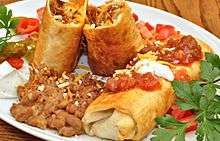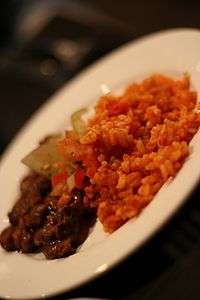Chimichanga
 Chimichangas | |
| Alternative names | Chivichanga |
|---|---|
| Type | Burrito |
| Place of origin | Northwestern Mexico/Southwestern United States |
| Main ingredients | Tortillas, rice, cheese, beans, machaca, jalapeño, carne adobada or shredded chicken |
Chimichanga (/tʃɪmiˈtʃæŋɡə/; Spanish: [tʃimiˈtʃaŋɡa]) is a deep-fried burrito that is popular in Tex-Mex, Southwestern U.S. cuisine. The dish is typically prepared by filling a flour tortilla with a wide range of ingredients, most commonly rice, cheese, beans, machaca (dried meat), carne adobada (marinated meat), carne seca (dried beef), or shredded chicken, and folding it into a rectangular package. It is then deep-fried and can be accompanied by salsa, guacamole, sour cream or cheese.
Origins
Debate over the origins of the chimichanga is ongoing.[1][2][3][4]
The words chimi and changa come from two Mexican Spanish terms: chamuscado (past participle of the verb chamuscar[5]), which means seared or singed, and changa, related to chinga (third-person present tense form of the vulgar verb chingar[6]), a rude expression for the unexpected or a small insult.[7]
According to one source,[8] Monica Flin, the founder of the Tucson, Arizona, restaurant El Charro, accidentally dropped a burrito into the deep-fat fryer in 1922. She immediately began to utter a Spanish profanity beginning "chi..." (chingada), but quickly stopped herself and instead exclaimed chimichanga, a Spanish equivalent of "thingamajig".[9]
Woody Johnson, founder of Macayo's Mexican Kitchen, claims he invented the chimichanga in 1946 when he put some burritos into a deep fryer as an experiment at his original restaurant Woody's El Nido. These "fried burritos" became so popular that by 1952, when Woody's El Nido became Macayo's, the chimichanga was one of the restaurant's main menu items. Johnson opened Macayo's in 1952.[2]
Although no official records indicate when the dish first appeared, retired University of Arizona folklorist Jim Griffith recalls seeing chimichangas at the Yaqui Old Pascua Village in Tucson in the mid-1950s.[10]
Given the variant chivichanga, mainly employed in Mexico, another derivation would have it that immigrants to the United States brought the dish with them, mainly through Nogales into Arizona. A third possibility is that the chimichanga, or chivichanga, has long been a part of local cuisine of the Pimería Alta of Arizona.
Knowledge and appreciation of the dish spread slowly outward from the Tucson area, with popularity elsewhere accelerating in recent decades. Though the chimichanga is now found as part of the Tex-Mex repertoire, its roots within the U.S. seem to be in Pima County, Arizona.[11]
According to data presented by the United States Department of Agriculture, a typical 183-gram (6.5-ounce) serving of a beef and cheese chimichanga contains 443 calories, 20 grams protein, 39 grams carbohydrates, 23 grams total fat, 11 grams saturated fat, 51 milligrams cholesterol, and 957 milligrams of sodium.[12][13][14]
See also
References
- ↑ Trulsson, Nora Burba (October 1999). "Chimichanga Mysteries: The Origin of Tucson's Deep-fried Masterpiece Is an Enigma Wrapped in a Tortilla". Sunset. ISSN 0039-5404. Retrieved 2009-03-19 – via HighBeam Research. (Subscription required (help)).
- 1 2 Henderson, John (2007-01-24). "We All Win as Chimichanga War Rages on". Food & Dining section. The Denver Post. Retrieved 2009-03-19.
- ↑ Laudig, Michele (2007-11-22). "Chimi Eat World: Arizona's deepest-fried mystery is smothered in cheese, guacamole and sour cream". Phoenix New Times.
- ↑ Lacey, Marc (2011-11-15). "Arizonans Vie to Claim Cross-Cultural Fried Food". The New York Times.
- ↑ "chamuscar". Diccionario de la lengua española (in Spanish). Real Academia Española.
- ↑ "chingar". Diccionario de la lengua española (in Spanish). Real Academia Española.
- ↑ Del Castillo, María (1966). Cocina mexicana [Mexican cuisine] (in Spanish) (5th ed.). México, D.F.: Editorial Olimpo. OCLC 4682105.
- ↑ Matteo Marra, "Tales of the chimichanga's origin"
- ↑ Stradley, Linda (April 27, 2017) [May 18, 2015]. "Chimichanga History and Recipe". What's Cooking America (blog).
- ↑ Miller, Tom (2000). Jack Ruby's Kitchen Sink: Offbeat Travels Through America's Southwest. p. 79. ISBN 9780792279594.
- ↑ Meesey, Chris (2009-04-29). "On The Range: Chimichangas". Dallas Observer.
- ↑ "Basic Report: 21071, Fast foods, chimichanga, with beef and cheese". United States Department of Agriculture. Archived from the original on 2014-11-08. Retrieved 2015-02-15.
- ↑ Stein, Natalie (May 22, 2012). "Nutrition Facts About Chimichangas". San Francisco Chronicle.
- ↑ Leeds, Jeff (1994-07-19). "The Whole Enchilada: It's Too Fat for You, Study Says". Los Angeles Times.
External links
| Wikimedia Commons has media related to Chimichanga. |


.jpg)

